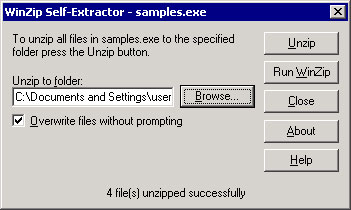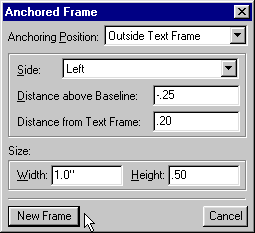FrameMaker 7.0 Tutorial: Anchored Frames
About Anchored Frames
You can use anchored frames to place graphics and illustrations within your document. When you place the anchored frame within your document, you can specify how the paragraph text will interact with the frame. For example, you can import a graphic into an anchored frame and specify that the paragraph text run around the graphic. To get started with this tutorial, you must first download and extract the sample files.
Downloading, Extracting, and Saving the Sample Files
Before you begin, you must download, extract, and save the sample files used in this tutorial.
To download the sample files:
- Select the following link: samples.zip.
Note: Earlier versions of Netscape may attempt to display this file directly. To force Netscape to download this file, right-click the link above, and select Save Link Target As. - Select the directory in which to save the file, and click Save.
Note: If you are working in the TCM computer lab, save the file to your lab account. If you do not have a lab account, please contact your instructor.
Before you extract the source files, make sure WinZip is installed on your computer. If WinZip is not installed, download the installation program from the following URL, and install WinZip: http://www.winzip.com.
To extract the source file:
- Locate the samples.exe file on your local computer.
- Double-click the file.
The following dialog box appears.

- Click Browse to select a directory in which to extract the files.
- Click Unzip.
The source documents are extracted to the selected directory.
- Click Close to close the dialog box.
To save the source documents:
- Open FrameMaker, and select File > Open.
- Change to the directory in which you extracted the source document.
- Select frames.fm, and click Open. (If messages appear, click OK to continue.)
- From the View menu, turn on Borders, Text Symbols, and Rulers.
- Select File > Save to save the file.
Importing a Graphic Using an Anchored Frame
To import a graphic using an anchored frame:
- Create a special paragraph tag that you use only for anchored frames. Doing so gives you global control over margins and spacing and other such formatting in all imported graphics in your document.
- Create an instance of this graphics-only tag in your document.
- Select File > Import > File.
- Select Copy into document. (For large documents, you’ll prefer using Import by reference to enable files to open and save faster.)
- Change to the directory in which you saved the sample files.
- Select dialogbox.tif, and click Import.
- In the Imported Graphic Scaling dialog box, select 150 dpi, and click Set.
FrameMaker inserts the graphic into the anchored frame. Note that
 (Anchor) marks the insertion point of the anchored frame.
(Anchor) marks the insertion point of the anchored frame.
- Select Special > Anchored Frame.
Notice the current settings place the anchored frame below the current line and aligned to the center of the text frame. These settings can be changed by using the pull-down menus.
- Click Cancel to exit.
Inserting an Anchored Frame To Run into the Paragraph
To insert an anchored frame that runs into the paragraph text, follow the steps below:
- Place your cursor anywhere in the first line of text (after First Heading).
- Select File > Import > File.
- Click on Pen&Fill.gif, and click Import.
- In the Imported Graphic Scaling dialog box, select 75 dpi, and click Set.
The graphic is placed in an anchored frame below the current line.
- Select Special > Anchored Frame.
- From the Anchored Frame dialog box, select Run into Paragraph from the Anchoring Position pull-down menu.
- Click Edit Frame.
The anchored frame is positioned within the text.
Inserting a Graphic in the Margin
To insert a graphic into the margin, you must:
- create an anchored frame outside the text frame
- import the graphic
- align the graphic within the anchored frame
- Create an anchored frame outside the text frame
- Click anywhere in the paragraph that reads “Place the insertion point here.”
- Select Special > Anchored Frame.
- From the Anchoring Position: pull-down menu, select Outside Text Frame.
- In the Distance above Baseline box, type -0.25. (A negative value places the frame below the baseline.)
- In the Distance from Text Frame box, type 0.2. (This option creates a small space between the graphic and the left edge of the text frame.)
- In the Size area, type 1.0 in the Width box and 0.5 in the Height box.
Your settings should look similar to the following.

- Click New Frame.
FrameMaker creates an anchored frame outside the text frame, on the left side of the page.
- Import the graphic:
- Select the anchored frame.
- Select File > Import > File.
- Change to the directory in which you saved the sample files, and select note.tif.
- Select the Copy into Document radio button located at the bottom of the dialog box.
Note: Copying a graphic into a document will increase the size of the document. To avoid increasing the size of the document, you can select Import by Reference. If you select Import by Reference and you are distributing the Framemaker source code, you must distribute the graphics directory as well. - Click Import.
- In the Imported Graphic Scaling dialog box, select 300 dpi, and click Set.
FrameMaker imports the graphic into the anchored frame.
- Align the graphic within the anchored frame:
- Select the graphic within the anchored frame. (Make sure you select the graphic and not the anchored frame.)
- Select Graphics > Align.
- In the Align dialog box, select Tops and Right Sides.
- Click Align.
FrameMaker aligns the graphic to top-right of the anchored frame.
Tip: You can also adjust the position of the graphic by one of the following methods:
-
Select the graphic, press and hold the Alt key, and then use the arrow keys to position the graphic. -
Right-click the graphic, select Object Properties, and then adjust the Offset From: Top: and Left: property values. Note: Notice that the anchored frame still has some extra space on the left side. To avoid awkward spacing with regard to objects outside the anchored frame, it is good practice to fit the anchored frame close to the graphic. The Snap feature allows you to resize frames at specified intervals. You can turn on or turn off the Snap feature by selecting Snap from the Graphics menu. To make finer adjustments to the size of your anchored frame, turn off the Snap feature.
In this tutorial you learned how to insert a graphic into an anchored frame, create an anchored frame that runs into a body paragraph, insert a graphic into the margin, and align a graphic within an anchored frame. Experiment with other anchored frame options to import your own graphics and illustrations.


Comments